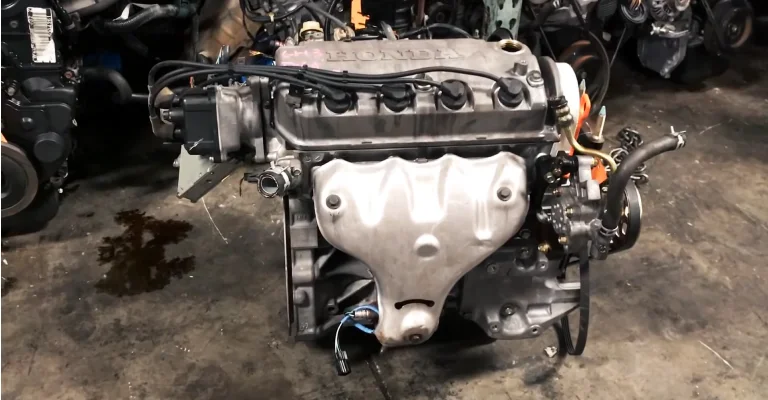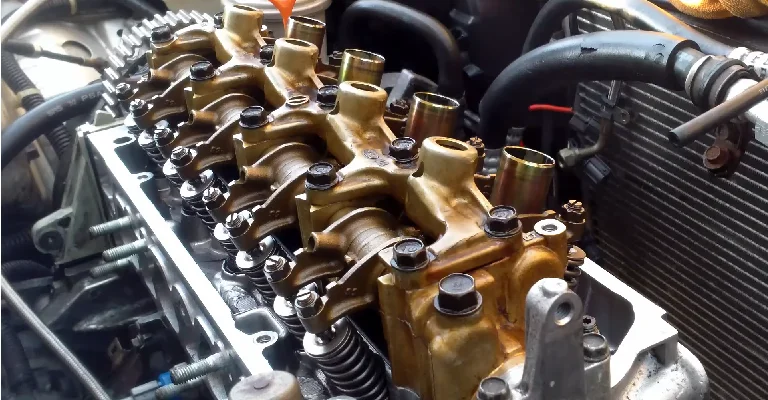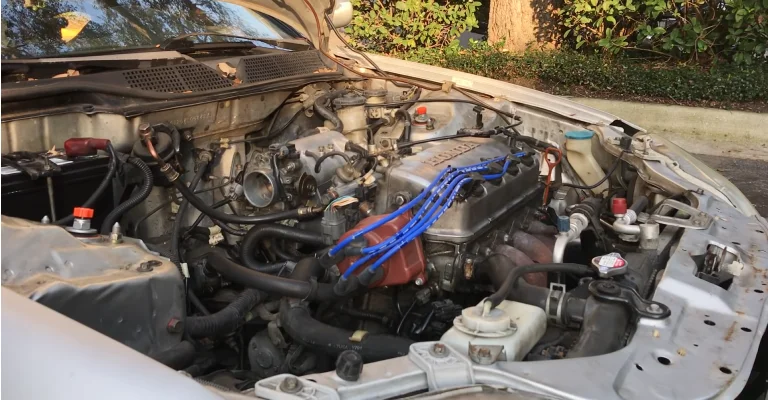The Honda D16Y8 engine is a 1.6-liter, 16-valve, SOHC VTEC engine that is found in a variety of Honda and Acura vehicles.
The 1996 model had 127 horsepower and 107 lb.-ft of torque right off the production line. Honda replaced the engine with the D17 series engine after only four years, but it remains popular to this day.
Between 1986 and 2007, Honda D-Series engines were used in some of the most popular Honda models of the 1990s. It is known for its high-revving capabilities and good power output.
The engine was first introduced in 1996 and was used in a number of popular Honda models such as the Del Sol Si, Civic EX, and Civic Si, as well as the Acura 1.6 EL.
The engine was also available in New Zealand and Pakistan under the code D16Y6.

D16Y8 VTEC Engine Specs
The Honda D16Y8 engine has a displacement of 1.6 liters, with a bore and stroke of 81mm x 77.4mm. It has a redline of 6800 rpm and a rev limit of 7200 rpm.
The engine’s ECU code is P2P and the piston code is also P2P. The engine uses OBD2-b fuel control and has a VTEC switchover point at 5,600 rpm.
The D16Y8 engine has a power output of 127 horsepower (95 kW) at 6600 rpm and torque of 107 lb⋅ft (145 N⋅m) at 5500 rpm.
The compression ratio is 9.6:1 and the deck height is 8.347 inches. The rod length is 5.394 inches. So, what is the specs of the D16Y8 VTEC engine?
| Specification | D16Y8 |
|---|---|
| Displacement | 1.590cc |
| Bore x Stroke | 81mm x 77.4mm |
| Redline | 6800 rpm |
| Rev Limit | 7200 rpm |
| ECU Code | P2P |
| Piston Code | P2P |
| Fuel Control | OBD2-b |
| VTEC Switchover | 5,600 rpm |
| Power Output | 127 horsepower (95 kW) at 6600 rpm |
| Torque Output | 107 lb⋅ft (145 N⋅m) at 5500 rpm |
| Compression Ratio | 9.6:1 |
| Deck Height | 8.347 inches |
| Rod Length | 5.394 inches |
Comparison to Other D16 Engines

When compared to other D16 engines, the D16Y8 offers a notable increase in performance and efficiency.
Compared to the D16Y6, the D16Y8 features a higher redline, more advanced fuel control, and a more powerful VTEC system, resulting in a significant increase in horsepower and torque output.
Additionally, the D16Y8 has a higher compression ratio which results in better fuel efficiency and a more responsive engine.
Compared to other D16 engines, the D16Y8 is considered to be one of the most powerful and efficient options available. It also has a relatively low emissions output and is compliant with OBD2 standards.
It’s worth noting that the D16Y8 was not available in all markets, some markets only had D16Y6 as an option.
Overall, the D16Y8 is considered to be an excellent choice for those looking for a high-performance, efficient engine for their Honda or Acura vehicle.
Head and Valvetrain Specs D16Y8

The Honda D16Y8 engine features a cast iron block, aluminum cylinder head and SOHC (Single Overhead Camshaft) valvetrain. The following are the specific specs for these components:
Block:
- Material: Cast iron
- Compression ratio: 9.6:1
- Deck height: 8.347 inches
Cylinder Head:
- Material: Aluminum
- Valves per cylinder: 4
- Valves Configuration: SOHC
Valvetrain:
- Configuration: SOHC
- Camshaft: Chain-driven
- Valve spring: Dual
- Rocker arm type: Roller
The D16Y8 engine also features a unique VTEC (Variable Valve Timing and Lift Electronic Control) system which enhances the engine’s performance by allowing for different valve timing and lift depending on the engine’s RPM.
The VTEC switchover point is at 5,600 rpm, this allows the engine to have a more efficient operation in low RPMs and more power in high RPMs.
The engine also features a OBD2-b fuel control and P2P ECU and Piston codes.
It’s worth noting that these specifications may vary depending on the specific vehicle the engine is installed in and the manufacturing year.
Honda D16Y8 Performance

The D16Y8 engine is a 1.6 liter four-cylinder engine that was used in the Honda Civic from 1996-2000. It is part of Honda’s D-series of engines, which are known for their reliability and efficiency.
The D16Y8 is known for its good fuel economy and low emissions, as well as its smooth and responsive power delivery.
In terms of performance, the D16Y8 engine is not known for its high horsepower numbers. Stock, it produces around 127 horsepower and 107 lb-ft of torque.
However, with some modifications, it is possible to increase its power output.
The D16Y8 was a powerful engine despite its 1.6L capacity. Variable Valve Timing and Lift Electronic Control (VTEC) is what made this engine special in the Civic EX.
A high-performance engine is able to adjust its timing automatically at low and high RPMs with this technology.
It produced 127 horsepower at 6,600 rpm and 107 lb-ft of torque at 5,500 rpm. The rev limit was 7,200 RPM and the redline was 6,800 RPM. Despite being marketed as a 1.6L, this engine had only 1,590cc or 97 cubic inches of displacement.
Approximately 75.0 mm (2.95 inches) of bore and 90.0 mm (3.54 inches) of stroke were used. As a result, the compression ratio was 9.6:1.
One of the most popular modifications is to install a larger throttle body, which can help to increase airflow into the engine, resulting in more horsepower and torque.
Another popular modification is to install a cold air intake, which can help to increase the amount of cool, dense air that enters the engine.
This can also help to increase horsepower and torque.
Upgrades and Modifications To Honda D16Y8 Engine
There are several common upgrades and modifications that can be made to the D16Y8 engine to improve performance. Some popular options include:
- Cold air intake: This modification increases the amount of air that the engine can take in, resulting in a noticeable increase in horsepower and torque.
- Exhaust system: A high-performance exhaust system can help to improve the engine’s breathing and increase horsepower and torque output.
- Camshafts: Upgrading to high-performance camshafts can improve the engine’s valve timing, resulting in increased horsepower and torque.
- Forced induction: Adding a turbocharger or supercharger to the engine can significantly increase horsepower and torque output.
- Engine management system: Upgrading the engine management system can allow for more precise tuning of the engine and can result in increased performance.
However, it’s important to note that some of these upgrades and modifications can have potential drawbacks or downsides.
For example, installing a cold air intake may decrease fuel efficiency. Forced induction can increase the stress on the engine and may require additional cooling and strengthening of engine components.
Also, installing high-performance camshafts can result in a less smooth idle and may require additional adjustments to the valvetrain. It’s important to consult with a professional mechanic or tuner before making any modifications to your engine.
Additionally, it’s important to be aware that some of these upgrades may void the vehicle’s warranty, or make the vehicle not compliant with emissions regulations.
Most Common Problems with D16Y8
The D16Y8 engine is a 1.6-liter, 4-cylinder engine that was produced by Honda for use in several of their vehicles. Some common problems associated with this engine include:
- Timing belt issues: The timing belt on the D16Y8 engine is known to wear out prematurely, which can cause the engine to stop running or cause internal damage.
- Valve adjustment: The valve clearance on the D16Y8 engine needs to be adjusted regularly, and if not done properly, it can cause poor engine performance and increased fuel consumption.
- Oil leaks: The D16Y8 engine is prone to oil leaks, which can be caused by a number of factors, including worn out gaskets and seals, or a damaged oil pan.
- Head gasket failure: The head gasket on the D16Y8 engine is known to fail, which can cause coolant to leak into the combustion chamber and cause engine damage.
- Throttle body issues: The throttle body on the D16Y8 engine can become clogged with carbon buildup, which can cause poor engine performance and increased fuel consumption.
- Engine mounting: The engine mounting on the D16Y8 engine can become worn out or damaged, which can cause engine vibrations and poor handling.
It is important to note that these problems may not occur in every D16Y8 engine, and regular maintenance and proper care can help prevent or reduce the likelihood of these issues.
Additionally, it should be mention that some of the above issues can be resolved by replacing the part in question and regular check-up, oil change, and using recommended lubricants are always a good idea.
FAQs
How Much HP Does A D16Y8 VTEC Have?
The D16Y8 is also known in New Zealand as the D16Y6 and is one of the most desirable D16 engines. With SOHC VTEC and a compression ratio of 9.6:1, it’s capable of pushing out 127 hp at 6,600 rpm with 107 lb/ft torque at 5,500 rpm with the VTEC switchover kicking in at 5,600 rpm.
How Many Cylinders Does A D16Y8 Have?
Honda’s D16Y8 engine is part of the Japanese carmaker’s D-series lineup. The 1.6-liter four-cylinder SOHC unit features Honda’s famous VTEC system on the intake side, giving it better performance than most D-series engines.
What Car Has The D16Y8 Engine?
In the United States the D16Y8 engine was found in Honda Civic EX models from 1996 to 2000. It also appeared in the Honda Del Sol Si until 1997.
Is A D16Y8 A 1.6 L?
Honda Civic VTEC D16Y8 Remanufactured Engine 1.6L 1995-2000
This is a remanufactured engine with all brand new OEM internals including pistons, rings, rod bearings, main bearings, and a full gasket set.
How Much More HP Does VTEC Add?
The 2.2-liter DOHC 16-valve 4-cylinder (H22A1) boasted 190 hp and 158 lb. -ft. of torque. Working much like the VTEC mechanism on the NSX, it produces an additional 30 horsepower compared to the 2.3-liter non-VTEC engine in the Prelude Si (H23A1).
How Do I Know If My D16 Is VTEC?
Final Words
The D16Y8 was a great engine in the Honda Civic EX and Del Sol Si without too many problems or complaints. In fact, it is still a popular swap engine for those looking to upgrade from previous versions of the D16 engine without VTEC.
Ultimately, this engine was phased out for the D17A2 in 2001. Although it was only produced for 4 years from 1996 to 2000 it remains a popular replacement engine.
Not to mention there is an overwhelming amount of aftermarket parts available at reasonable prices. You can increase the horsepower of this engine by adding a cold air intake and turbocharger.

Leave a Reply